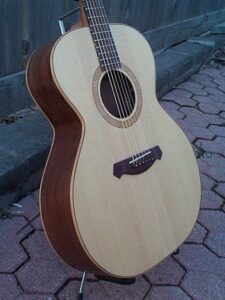Birth of a luthier

I began building my first acoustic guitar in 2000. It was slow going. Not only did I have to research each step of the process but I also had to build a number of the required jigs and specialty tools as well. I stuck with it though and after nine or ten months that guitar was finally completed and I was hooked.
In the years since, I’ve built many guitars, taken a break as life and other interests got in the way, and eventually picked it up and fell in love with the process all over again.
I’d say I was self-taught, but that wouldn’t be entirely true. Over the years I’ve been taught by a number of world renowned luthiers, studying the writings and teachings of such masters as Irving Sloane, William Cumpiano, Don Teeter, Kent Everett, and Ervin Somogyi. Years before there was YouTube and Facebook, I was an active participant in the online community that was the Musical Instrument Makers Forum, sharing with and learning from the myriad of expert luthiers and fine craftspeople who frequented there. I’ve long been a member of the Guild of American Luthiers, learning from the wealth of knowledge and expertise contained in their quarterly and annual publications.
I enjoy learning, developing new ideas and trying new things. Over the years, I’ve continued to refine my building process as I figure out what works for me and what doesn’t. I build only a few instruments each year and purposely make a point of not repeatedly building the same thing. That keeps it exciting for me and helps to insure that each instrument I make is an interesting creation.
In the late 1990’s and into the early 2000’s, there was a smallish musical instrument company based in Washington state called Tacoma Guitars. The company was eventually swallowed up by Fender and has long since stopped producing instruments, but during their heyday, Tacoma produced some interesting acoustic guitars using a non-traditional, minimalist approach to bracing and adornments. Several of their models sported a sound hole in the guitars upper bout. The Tacoma guitars were perhaps not terribly well made, but several of the ideas that they incorporated intrigued me and had an influence on the design of some of my early instruments.
These days, I tend to build guitars based on derivatives of well known body shapes. People recognize names such as double 0 and triple 0 and generally understand what to expect from them in terms of size, performance, playing comfort, etc. However, what I build are not copies of other manufacturers instruments. I incorporate many of my own ideas, features such as side sound ports, carbon fibre neck buttresses, non-central sound holes, end block access ports, various traditional and less-traditional wood choices and of course, my own take on bracing design and soundboard voicing. The results, I believe, are stunning one-of-a-kind instruments that truly look amazing, play wonderfully, and sound incredible. At the same time, I make every effort to keep the prices of these creations within the reach of mere mortals. I invite you to try one of my guitars. I honestly believe you’ll fall in love.